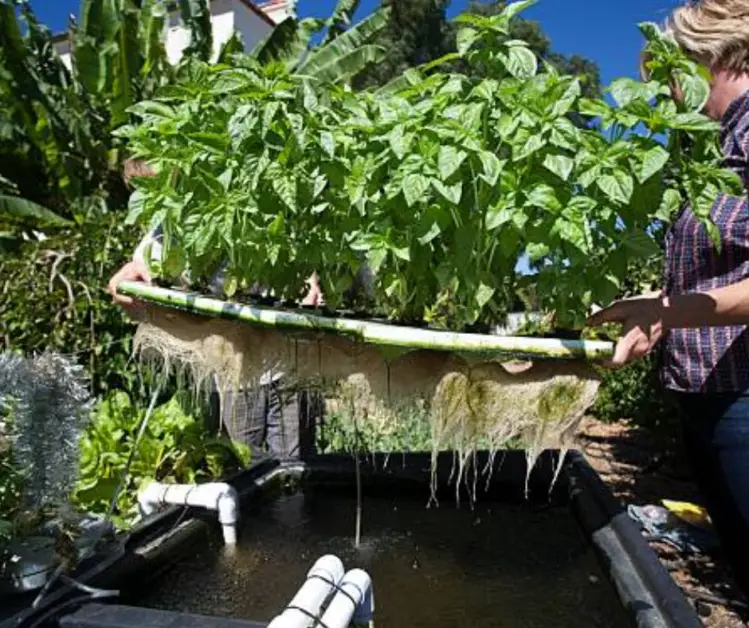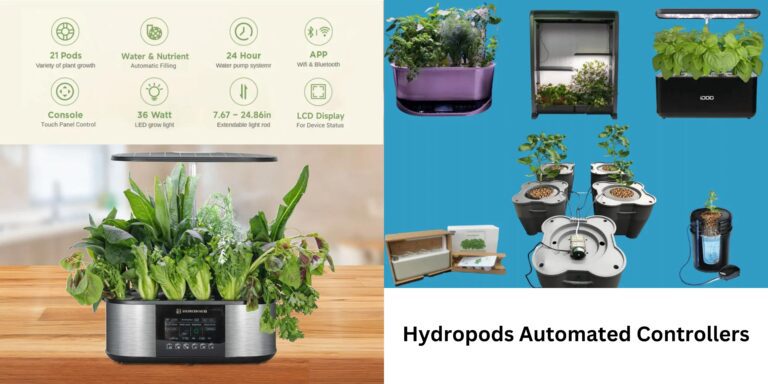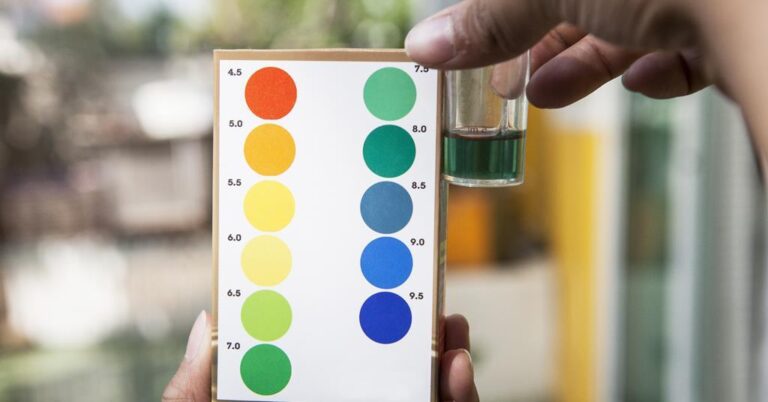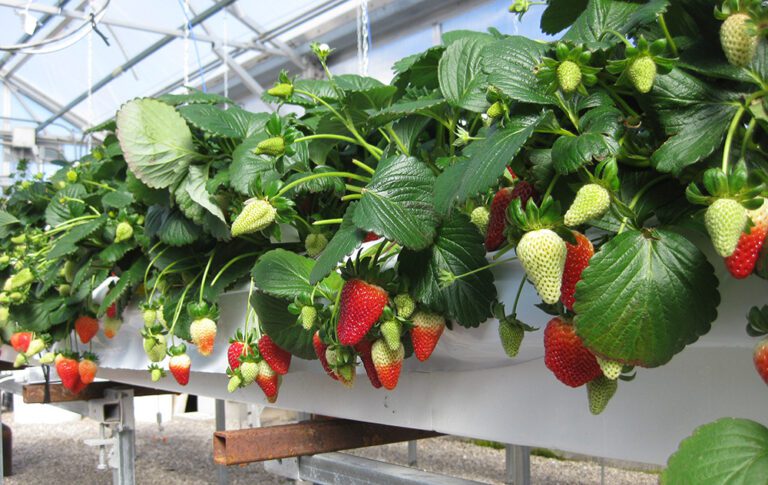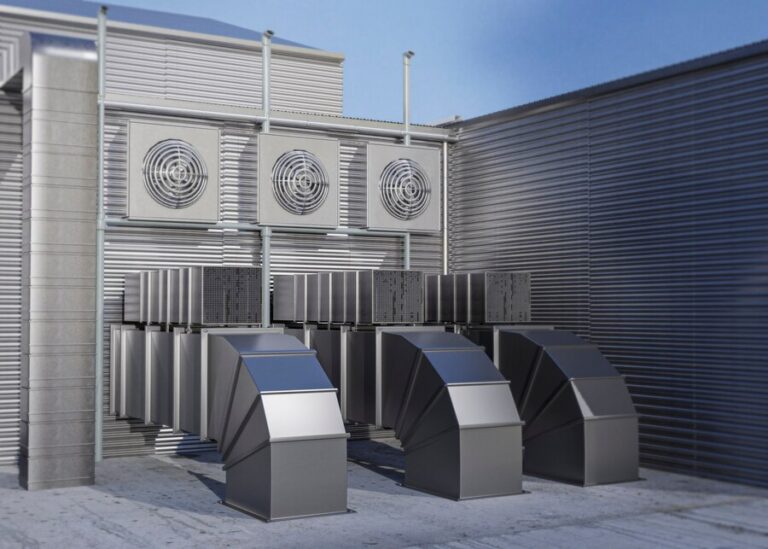Hydroponics vs Aquaponics: The Ultimate Comparison You Can’t Afford to Miss
Table of Contents
Introduction
Have you ever wondered how plants can grow without soil? If you are looking for alternative and sustainable ways to produce fresh and healthy food, you might be interested in learning about hydroponics and aquaponics. These are two methods of soil-less gardening that use aquatic solutions and fish to provide nutrients and water to plants. In this article, we will compare and contrast hydroponics and aquaponics in terms of their system design, cost, maintenance, benefits, and drawbacks. We will also give you some tips on how to choose the best system for your needs and goals. By the end of this article, you will have a better understanding of the similarities and differences between hydroponics and aquaponics, and how they can help you grow your own food in an efficient and eco-friendly way.
Hydroponics vs Aquaponics: Methods
Hydroponics and aquaponics are two methods of soil-less gardening that use aquatic solutions and fish to provide nutrients and water to plants. However, they differ in how they are designed and what components they use. In this section, we will compare and contrast the basic elements of each system, such as the water reservoir, the growing medium, the pump, the filter, the fish tank, etc. We will also use diagrams or images to illustrate the differences.
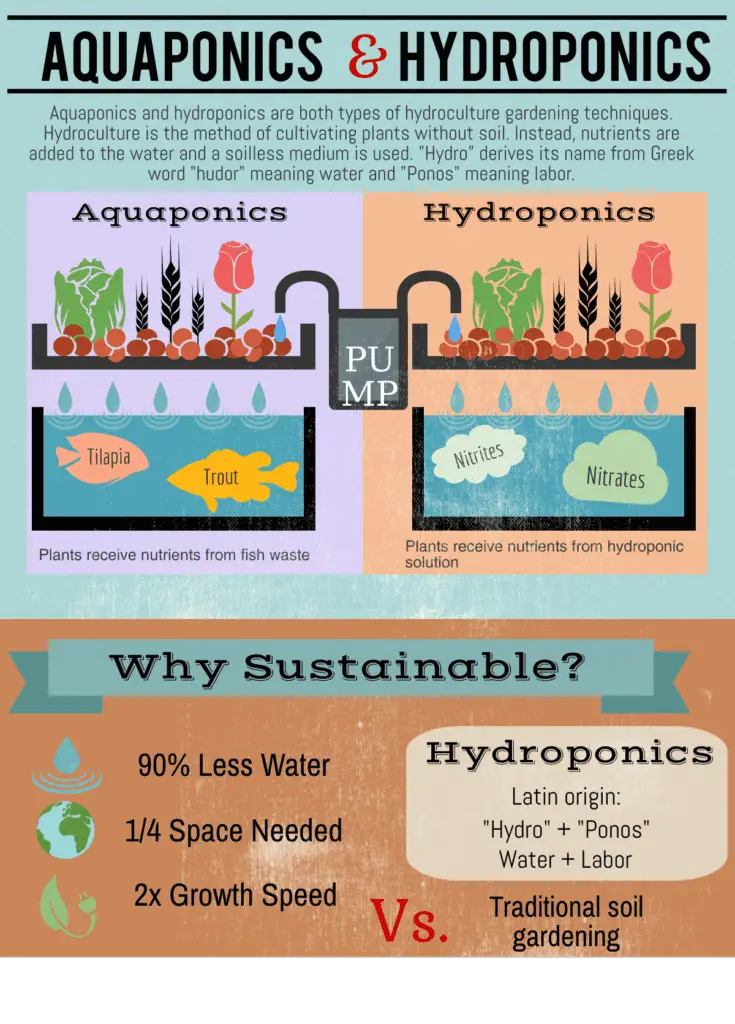
Water Reservoir
The water reservoir is the container that holds the nutrient solution or the water for the system. In hydroponics, the water reservoir is usually separate from the plant growing area, and the nutrient solution is added manually or automatically to the water. The water reservoir can be made of plastic, metal, or other materials, and it can have various shapes and sizes, depending on the system design and the space available. The water reservoir should be dark or covered to prevent algae growth and evaporation.
In aquaponics, the water reservoir is usually the same as the fish tank, and the nutrient solution is produced by the fish waste. The water reservoir can also be made of different materials, but it should be large enough to accommodate the fish and provide adequate oxygen and water quality. The water reservoir should also have a lid or a cover to prevent fish from jumping out and to reduce water loss.
Growing Medium
The growing medium is the material that supports the plant roots and provides aeration and drainage. In hydroponics, the growing medium can be inert or organic, and it can have various textures and properties. Some common examples of hydroponic growing media are rockwool, perlite, vermiculite, coco coir, clay pebbles, gravel, sand, etc. The growing medium should be sterile, lightweight, porous, and pH-neutral.
In aquaponics, the growing medium can be similar to hydroponics, but it should also be suitable for the bacteria that convert the fish waste into plant nutrients. Some common examples of aquaponic growing media are expanded clay, lava rock, gravel, etc. The growing medium should also be inert, durable, and easy to clean.

Pump
The pump is the device that moves the water or the nutrient solution from the reservoir to the plant growing area and back. In hydroponics, the pump can be submersible or external, and it can have various capacities and flow rates, depending on the system design and the water volume. The pump should be powerful enough to deliver the nutrient solution to the plants at the desired frequency and duration, and it should be reliable and energy-efficient.
In aquaponics, the pump can also be submersible or external, and it can have similar characteristics as hydroponics, but it should also be compatible with the fish and the bacteria. The pump should not harm the fish or disturb the biofilter, and it should be able to handle the solids and the organic matter in the water.
Filter
The filter is the component that removes the solids and the organic matter from the water or the nutrient solution. In hydroponics, the filter is usually optional, as the nutrient solution is relatively clean and free of debris. However, some hydroponic systems may use a filter to prevent clogging of the pipes or the drippers, or to improve the water quality. The filter can be mechanical, biological, or chemical, and it can have various types and sizes, depending on the system design and the water volume.
In aquaponics, the filter is essential, as the water is rich in fish waste and organic matter. The filter serves two main functions: to remove the solids and to provide a surface for the bacteria to grow. The filter can be divided into two stages: the mechanical filter and the biofilter. The mechanical filter can be a screen, a swirl, a clarifier, or a settler, and it can remove the large particles and the suspended solids from the water. The biofilter can be a media bed, a trickling filter, a moving bed, or a fluidized bed, and it can host the bacteria that convert the ammonia and the nitrite into nitrate. The filter should be efficient, easy to maintain, and well-aerated.
Fish Tank
The fish tank is the component that houses the fish and provides the water for the system. In hydroponics, the fish tank is not present, as the system does not involve fish or other aquatic animals. In aquaponics, the fish tank is one of the most important components, as the fish are the source of the nutrients and the income for the system. The fish tank can be made of various materials, such as plastic, fiberglass, metal, or concrete, and it can have various shapes and sizes, depending on the system design and the fish species. The fish tank should be large enough to accommodate the fish and provide adequate oxygen and water quality. The fish tank should also have a heater, an aerator, a thermometer, and a pH meter to control the temperature, the dissolved oxygen, the pH, and other water parameters.
Hydroponics Vs aquaponics: Commercials
Hydroponics and aquaponics are two methods of soilless gardening that use aquatic solutions and fish to provide nutrients and water to plants. However, they differ in how much they cost and how much effort and skill they require to operate and maintain. In this section, we will compare and contrast the initial and ongoing expenses of each system, such as the equipment, the nutrients, the fish, the electricity, the water, etc. We will also discuss the level of effort and skill required to operate and maintain each system.
Initial Costs
Hydroponics systems are generally cheaper and simpler to set up than aquaponics systems. They don’t require as many components, and the cost of the nutrient solution is typically less than the cost of purchasing and caring for aquatic animals. According to one source1, the average cost of setting up a hydroponics system is around $500, while the average cost of setting up an aquaponics system is around $1,000. However, these costs may vary depending on the size, type, and quality of the system and the materials used.
Aquaponics systems require extra components, such as filtration, aeration, and fish tanks, which add to the initial cost. They also require buying and stocking fish, which can be expensive and challenging, depending on the availability and legality of the fish species. Additionally, aquaponics systems require a longer acclimation or cycling period, which can take 6 to 8 weeks, before they can reach full productivity. This means that the return on investment may take longer for aquaponics than for hydroponics.
Ongoing Costs
Hydroponics systems have lower ongoing costs than aquaponics systems, but they also have lower potential profits. The main ongoing costs for hydroponics systems are the nutrient solution, the electricity, and the water. The nutrient solution has to be carefully managed and replenished, as it can lose its effectiveness over time or become contaminated. The electricity cost depends on the type and size of the pump, the lighting, and the heating or cooling system. The water cost depends on the water source, the quality, and the frequency of replenishment.
Aquaponics systems have higher ongoing costs than hydroponics systems, but they also have higher potential profits. The main ongoing costs for aquaponics systems are the fish food, the electricity, and the water. The fish food is the primary source of nutrients for the plants, and it has to be of high quality and quantity to ensure the health and growth of the fish and the plants. The electricity cost is similar to hydroponics, but it may be slightly higher due to the need for additional air pumps. The water cost is lower than hydroponics, as aquaponics systems recycle water between the fish tanks and the plant beds, and they don’t require flushing.
Effort and Skill
Hydroponics systems require more effort and skill than aquaponics systems to operate and maintain. They require daily monitoring and testing of the nutrient solution, the pH, the EC, and the temperature. They also require regular cleaning and maintenance of the equipment, the pipes, the drippers, and the growing medium. They may also require pest and disease control, as hydroponics systems are more prone to infections and infestations than aquaponics systems.
Aquaponics systems require less effort and skill than hydroponics systems to operate and maintain. They require weekly or biweekly monitoring and testing of the water quality, the ammonia, the nitrite, the nitrate, and the pH. They also require occasional cleaning and maintenance of the filters, the pumps, and the growing medium. They may also require fish health and welfare management, such as feeding, harvesting, and restocking. They are less likely to suffer from pests and diseases, as aquaponics systems have a natural balance of microorganisms and beneficial insects.
Commercial Applications of Aquaponics
Aquaponics, a combination of aquaculture and hydroponics, is gaining popularity as a sustainable and efficient method of food production. With its myriad commercial applications, aquaponics offers several advantages over conventional farming practices. One of the main benefits is its water efficiency. Compared to traditional farming, aquaponics uses up to 90% less water, making it an ideal solution for areas with limited water resources. Additionally, the closed-loop system of aquaponics minimizes the need for chemical fertilizers and pesticides, making it an eco-friendly alternative that reduces the negative impact on the environment and human health. These factors make aquaponics an attractive option for commercial growers looking for sustainable and responsible farming methods.
• Aquaponics uses up to 90% less water compared to traditional farming methods.
• The closed-loop system minimizes the need for chemical fertilizers and pesticides.
• Aquaponics reduces the negative impact on the environment and human health.
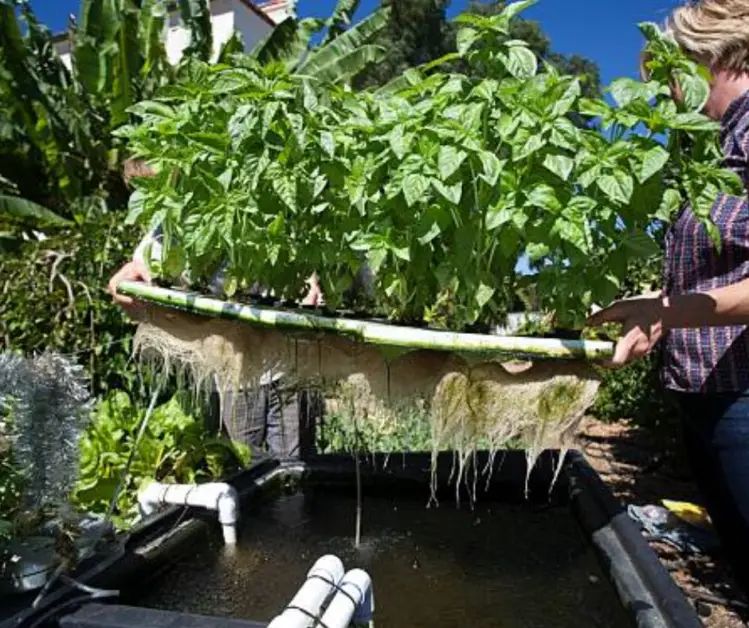
| Application | Description |
|---|---|
| Urban Agriculture | Aquaponics is ideal for urban areas with limited resources and space. It can be used to raise both fish and vegetables in an integrated system . |
| Commercial Farming | Aquaponics can be used to sustainably raise fresh fish and vegetables year-round, in any climate . |
| Education | Aquaponics can be used as a teaching tool to educate students about emerging and future technologies in aquaculture . |
| Industrial Scale Production | Aquaponics can be used for industrial scale production in rural areas . |
| Small Scale Farming | Aquaponics can be used for small scale farming in developing countries |
Commercial Applications of Hydroponics
Commercial applications of hydroponics system are the use of hydroponics for large-scale production of crops, usually for profit or research purposes. Hydroponics is a method of growing plants without soil, using a nutrient solution and a growing medium to provide water and nutrients to the roots. Hydroponics has several advantages over conventional agriculture, such as:
- Higher yields and faster growth rates, as plants can receive optimal levels of nutrients and oxygen.
- Less water and land use, as hydroponics systems recycle water and can be stacked vertically or horizontally.
- Less fertilizer and pesticide use, as hydroponics systems prevent nutrient runoff and soil-borne diseases.
- More versatility and adaptability, as hydroponics systems can grow a wide range of plants in any location, climate, or season.
Some examples of commercial applications of hydroponics system are:

- Urban farming: Hydroponics systems can be used to grow fresh and local food in urban areas, where land and water are scarce and expensive. Hydroponics systems can be installed on rooftops, balconies, warehouses, or containers, and can supply food to nearby markets, restaurants, or consumers. Urban farming can also reduce food miles, carbon footprint, and waste, and improve food security and quality.
- Cannabis cultivation: Hydroponics systems can be used to grow cannabis, which is a high-value crop with increasing demand and regulation. Hydroponics systems can offer more control and precision over the growth environment, such as the nutrient levels, the pH, the EC, and the temperature. Hydroponics systems can also produce higher-quality and more consistent cannabis, as they can prevent or treat pests and diseases, and avoid contamination from soil or fish.
- Ornamental plants: Hydroponics systems can be used to grow ornamental plants, such as flowers, foliage, or bonsai, which are popular for decoration, gifts, or hobbies. Hydroponics systems can produce more beautiful and healthy ornamental plants, as they can provide optimal levels of nutrients and oxygen, and enhance the color and aroma of the plants. Hydroponics systems can also reduce the labor and maintenance required for ornamental plants, as they can automate the watering and feeding process, and avoid soil-related problems.
- Research and education: Hydroponics systems can be used for research and education purposes, such as studying plant physiology, genetics, or ecology, or teaching students about botany, biology, or chemistry. Hydroponics systems can offer a convenient and accessible way to conduct experiments and observations on plants, as they can isolate and manipulate various factors, such as the nutrient solution, the light, or the temperature. Hydroponics systems can also provide a fun and engaging way to learn about plants, as they can demonstrate the principles and processes of plant growth and development.
Hydroponics Vs aquaponics: Output
Yield
Hydroponics systems tend to have higher yields than aquaponics systems, as they allow for more precise control of the nutrient levels, the pH, the EC, and the temperature. Hydroponics systems can also grow plants faster, as they deliver the nutrients directly to the roots, without any competition or interference from the fish or the bacteria. According to one study1, hydroponics systems produced 11% more lettuce and 8% more basil than aquaponics systems.
Aquaponics systems have lower yields than hydroponics systems, as they depend on the fish waste and the bacteria to provide the nutrients, which can be variable and unpredictable. Aquaponics systems can also grow plants slower, as they have to balance the needs of the fish and the plants, and avoid overloading the system with nutrients or toxins. However, aquaponics systems can still produce substantial amounts of food, especially if they are well-designed and well-managed. According to another study2, aquaponics systems produced 20 kg of tilapia and 51 kg of lettuce per square meter per year.
Quality
Hydroponics systems can produce high-quality plants, as they can prevent or treat pests and diseases more easily, and avoid any contamination from the fish or the bacteria. Hydroponics systems can also produce more uniform and consistent plants, as they can adjust the nutrient solution to suit the specific needs of each crop. However, hydroponics systems can also produce lower-quality plants, as they can cause nutrient deficiencies or toxicities, and affect the taste and the aroma of the plants.
Aquaponics systems can produce high-quality plants, as they can benefit from the natural and organic nutrients from the fish and the bacteria, and enhance the flavor and the aroma of the plants. Aquaponics systems can also produce more diverse and resilient plants, as they can mimic the natural cycles and interactions of aquatic ecosystems. However, aquaponics systems can also produce lower-quality plants, as they can suffer from pests and diseases, and be affected by the water quality and the fish health.
Sustainability
Hydroponics systems are more sustainable than conventional agriculture, as they use less water, less land, less fertilizer, and less pesticide. Hydroponics systems can also be more sustainable than aquaponics systems, as they use less electricity, less fish food, and less maintenance. However, hydroponics systems are less sustainable than aquaponics systems, as they produce more waste, more pollution, and more greenhouse gas emissions. Hydroponics systems also rely on synthetic and non-renewable nutrients, which can be costly and harmful to the environment.
Aquaponics systems are more sustainable than conventional agriculture and hydroponics, as they use less water, less land, less fertilizer, less pesticide, less electricity, less fish food, and less maintenance. Aquaponics systems can also be more sustainable than hydroponics systems, as they produce less waste, less pollution, and less greenhouse gas emissions. Aquaponics systems also rely on natural and renewable nutrients, which can be cheaper and safer for the environment.
Versatility
Hydroponics systems are more versatile than aquaponics systems, as they can grow a wider range of plants, without any restrictions or limitations from the fish or the bacteria. Hydroponics systems can also grow plants in any location, climate, or season, as they can be indoors or outdoors, and use artificial lighting or heating. However, hydroponics systems are less versatile than aquaponics systems, as they can only grow plants, and not fish or other aquatic animals.
Aquaponics systems are less versatile than hydroponics systems, as they can grow a limited range of plants, depending on the compatibility and the compatibility with the fish and the bacteria. Aquaponics systems can also grow plants in fewer locations, climates, or seasons, as they have to be outdoors or in greenhouses, and use natural lighting or heating. However, aquaponics systems are more versatile than hydroponics systems, as they can grow plants and fish, and provide a source of protein and income.
Environmental Impact
Hydroponics systems have a positive environmental impact, as they conserve water, reduce soil erosion, prevent nutrient runoff, and decrease pesticide use. Hydroponics systems can also have a negative environmental impact, as they consume electricity, generate waste, emit carbon dioxide, and use synthetic nutrients. Hydroponics systems can also have a neutral environmental impact, as they have no effect on the biodiversity, the ecosystem services, or the natural resources of the surrounding environment.
Aquaponics systems have a positive environmental impact, as they conserve water, reduce soil erosion, prevent nutrient runoff, decrease pesticide use, consume less electricity, generate less waste, emit less carbon dioxide, and use natural nutrients. Aquaponics systems can also have a negative environmental impact, as they can introduce invasive species, spread diseases, affect the water quality, and harm the welfare of the fish. Aquaponics systems can also have a positive environmental impact, as they can increase the biodiversity, the ecosystem services, and the natural resources of the surrounding environment.
Marketability
Hydroponics systems have a high marketability, as they can produce large quantities of plants, with high quality, uniformity, and consistency. Hydroponics systems can also have a low marketability, as they can face competition, regulation, and consumer skepticism. Hydroponics systems can also have a medium marketability, as they can appeal to niche markets, such as urban, organic, or specialty crops.
Aquaponics systems have a high marketability, as they can produce large quantities of plants and fish, with high quality, diversity, and resilience. Aquaponics systems can also have a low marketability, as they can face competition, regulation, and consumer skepticism. Aquaponics systems can also have a medium marketability, as they can appeal to niche markets, such as urban, organic, or specialty crops.
This table compares hydroponics and aquaponics in terms of various aspects.
| Aspect | Hydroponics | Aquaponics |
|---|---|---|
| Cost | Lower initial cost, higher ongoing cost due to nutrient solution, electricity, and water. | Higher initial cost, lower ongoing cost due to fish food, electricity, and water. |
| Yield | Higher yield of plants, faster growth rate, more precise control of nutrient levels. | Lower yield of plants, slower growth rate, less control of nutrient levels. |
| Output | Only plants, no fish or other aquatic animals. | Plants and fish, providing a source of protein and income. |
| Profitability | Lower potential profit, depending on the type and quality of plants. | Higher potential profit, depending on the type and quality of plants and fish. |
| Area | Less land use, can be stacked vertically or horizontally, can be indoors or outdoors. | Less land use, can be stacked vertically or horizontally, usually outdoors or in greenhouses. |
| Size | Smaller and simpler system, fewer components, easier to set up and scale up. | Larger and more complex system, more components, harder to set up and scale up. |
| Challenges | Maintaining the nutrient solution, the pH, the EC, and the temperature. Preventing or treating pests and diseases. Managing the waste and the pollution. | Maintaining the water quality, the ammonia, the nitrite, the nitrate, and the pH. Caring for the fish health and welfare. Balancing the needs of the fish and the plants. |
Watch this video for more about hydroponics vs aquaponics:
FAQS about hydroponics vs aquaponics
What are some commercial applications of Aquaponics?
Aquaponics has a wide range of commercial applications across various industries.
How is Aquaponics used in the agriculture industry?
Aquaponics is commonly used in agriculture for irrigation purposes. It helps in efficient water management and enhances crop growth and yield.
Can Aquaponics be used in the manufacturing sector?
Yes, Aquaponics is often used in manufacturing for processes such as cooling, cleaning, and product formulation. It helps in maintaining optimal production conditions and quality control.
Are there any commercial uses of Aqu in the healthcare industry?
Absolutely! Aquaponics is utilized in healthcare for medical device manufacturing, sterilization, and laboratory procedures. It ensures a safe and hygienic environment for medical facilities.
Can Aquaponics be beneficial in the energy sector?
Yes, Aquaponics plays a significant role in the energy sector. It is used in power plants for cooling systems and steam production. Aquaponics is also utilized in renewable energy technologies like hydroelectric power generation.
How is Aqu employed in the food and beverage industry?
Aquaponics is crucial in the food and beverage industry for cleaning, sanitation, and ingredient preparation. It helps maintain food safety standards and ensures high-quality products.
Are there any commercial applications of Aquaponics in the construction sector?
Absolutely! Aquaponics is utilized in construction for concrete mixing, dust suppression, and construction site cleaning. It aids in maintaining a clean and safe working environment.
Can Aquaponics be used in the transportation industry?
Yes, Aquaponics has applications in the transportation industry as well. It is used for vehicle washing, cooling systems, and maintenance procedures. Aquaponics helps in ensuring the efficiency and longevity of transportation assets.
How is Aquaponics beneficial in the hospitality industry?
Aquaponicsis widely used in the hospitality industry for laundry, cleaning, and sanitation purposes. It helps maintain cleanliness and hygiene in hotels, restaurants, and other hospitality establishments.
Are there any innovative uses of Aqu in the technology sector?
Absolutely! Aquaponics is employed in the technology sector for electronic component manufacturing, computer chip cooling, and data center operations. It aids in maintaining optimal performance and reliability of technological infrastructure.

